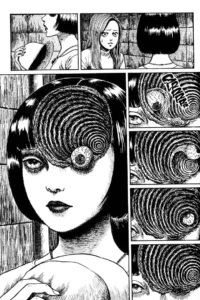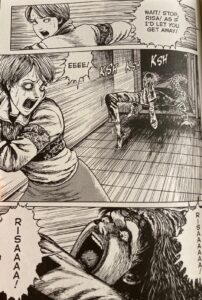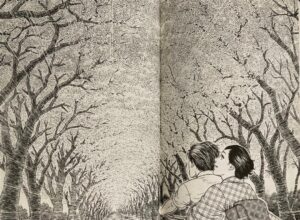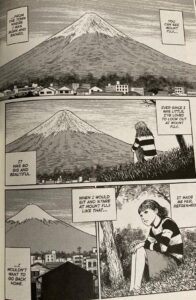Bizarre Bath
The Works of Author and Illustrator Junji Ito
**if you are viewing this on your phone, scroll to bottom to get free read link**
Junji Ito’s extraordinary talent goes without saying. He is a master of crafting nightmares from which there is no waking. Interested in horror manga from a young age, he published his first work in 1987. His line work and distinctive, detailed style only enhances every character’s transition from warm, inviting normalcy to get-the-f*ck-out-of-here, this-isn’t-happening pit of unexpected horror dread.
If you’re going to dip your toe into this bizarre bath of horror, you should know that Junji Ito’s art and manga comes from age old wells of inspiration.
He draws from the spring of not only his own experiences, but also from:
- Hideshi Hino (The Hino Horror Series)
- Yasutaka Tsutsui (Paprika, The Girl Who Leapt Through Time)
- Kazuo Umezu (The Drifting Classroom)
- H.P. Lovecraft (Call of Cthulhu, Color Out of Space).
With his own imaginative originality, he seamlessly weaves the traditional horror tropes with deeper human themes to form some of the most eerily beautiful spectacles in the horror genre.
In the words of H.P. Lovecraft
“…the essence of the horrible is the unnatural”
(“In Defense of Dagon”,Collected Essays of H.P. Lovecraft,vol. 5).
Make no mistake, Junji Ito takes the unnatural to a whole new level.
So, What Makes Junji Ito’s Work So Terrifying?
Ito does not just throw you into the Lovecraftian horror norm of an individual or group trapped in an inescapable environment forced to face an impossible (and possibly supernatural) threat that they barely understand, yet are forced to confront.
(Okay, he does a lot of that…)
He also pushes these limits by layering deeper themes, like the fragility of the human psyche, cosmic dread, and the nature of obsession (like a layer cake of doom) into his stories. Then, he slaps you with the cold hard hand of bizarre, imaginative originality.
This is showcased in some of his most popular work. Whether it’s an entire ocean full of genetically mutated sea life that invades dry land (Gyo), a seemingly undead femme fatale that drives her lovers to madness (Tomie), or a hypnotic spiral that washes an entire town down the drain of insanity (Uzumaki), Ito doesn’t let up with the bone-chilling sense of the terrifying.
Even if the story only lasts a few panels or extends over a volume of over 600 pages, the authentic novelty of his ideas are never diminished. With an author that can even make a story about a futon disgustingly unnerving (Yes! A futon!), would we expect anything less?
The Art of Junji Ito: Engrossing or Just Gross?
A little bit of both as I myself will attest to cringing at the image of a brother squeezing the oozing puss of his acne onto his sister’s face (Greased).
Ito himself explains where such mental images came from in the Author Commentary in some of his books. He describes having had to help clean a Buddhist temple while attending dental technician school.
“The futons they had at the temple hadn’t been aired out for who knew how many years, like they were fermenting them inside the humid closets, and they were stained solid brown from the sweat of the Buddhist students…
Sleeping on that sticky futon on the hot, humid summer nights was really difficult ascetic practice. I wanted to put that discomfort into the manga.” (p. 383, Shiver)
That is some of the genius in his illustration style. The reader can feel the desperate, sticky, grungy struggle for air!
It’s not just the creepy, macabre, or blood spattered panels that showcase Ito’s talent. He expertly and artfully employs not only tension and texture, but movement and motion into his paneling.
An entrancing panel as a girl’s face slowly implodes (Uzumaki).

A boy menacingly spider crawls toward his victim (Honored Ancestors, (p. 347, Shiver).

On a bike, zooming in between rows of cherry blossom trees, you can almost feel the wind whipping your face along with the characters as they travel onto the next page of the story (p. 262 – 263, No Longer Human).

Let’s also not forget to include the expansive landscapes that also impress and give the reader a sense of scope. A young girl wistfully watching Mt. Fuji only further proves the mastery of technique (Greased, p. 352, Shiver).

Hard to believe a guy who studied to be a dental technician could produce such artistry that questions the very meaning of reality.
Horror of the Unexpected
Would you think that something as simple as listening to a record(Used Record), getting a song stuck in your head (Splendid Shadow Song), a fit of laughter (Ghost of Prime Time), or even someone apologizing to you (Dissolving Classroom) could spark a horrifying set of events from which there is no escape?
Death, the baseline of the horror genre, is inevitable. We all accept this inescapable fun fact of life. When death finally comes knocking, will it come in the form of a floating balloon with your face on it conveniently dangling a noose (Hanging Balloons)?
There’s no way of telling.
Enticingly detailed illustrations that pull you into the story. Narratives that blur reality. This is why Junji Ito’s art and manga is some of the best work in the genre of horror. The layering of immersive storytelling, detailed illustrations, and imaginative ideas crafts a legacy that will echo through those long, dark, dingy halls of the creepy and bizarre forever.